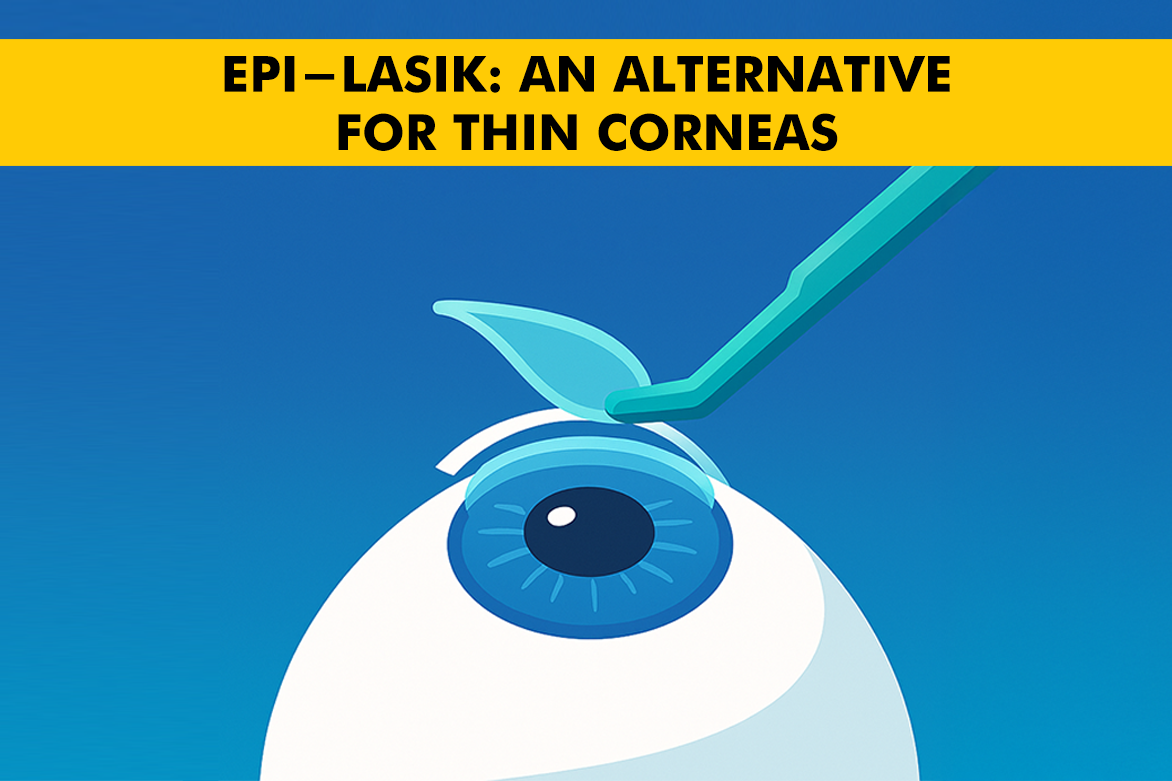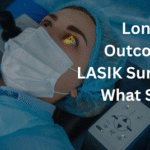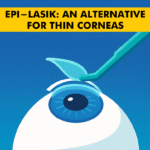Table of Contents
- What Is Epi-LASIK?
- Why Patients with Thin Corneas Need a Different Approach
- Epi-LASIK Treatment: Step-by-Step Procedure
- Benefits of Epi-LASIK
- Recovery After Epi-LASIK
- Risks and Considerations
- Who Should Consider Epi-LASIK?
- Frequently Asked Questions (FAQs)
Epi-LASIK is a laser eye surgery that reshapes the cornea to correct your vision. This advanced technology is a great option for people with thin corneas who may not qualify for LASIK surgery. Instead of creating a flap, in the Epi-LASIK, the outer corneal layer is gently separated and repositioned after the treatment. This surgery takes slightly longer than LASIK to recover, but usually involves less discomfort.
Here, we tell you everything you need to know about Epi-LASIK: why it’s needed, the step-by-step procedure, its benefits, recovery, risks, and who should consider it.
What Is Epi-LASIK?
Epi-LASIK surgery is an advanced refractive treatment that enables clear vision without glasses or contact lenses. This method is similar to LASIK, but it involves separating a thinner epithelial layer, which doesn’t go deeper than the epithelium. To understand its unique advantages, let’s compare it to other vision correction surgeries like LASIK and PRK.
How is Epi-LASIK different from regular LASIK and PRK?
Epi-LASIK is a surface laser vision correction surgery, similar to PRK, as it removes or lifts only the outer epithelial layer, unlike LASIK, which creates a deep corneal flap, and avoids deeper cuts. Epi-LASIK provides a safer and more controlled treatment for those eyes that are too thin or are at risk of trauma. Compared to LASIK, Epi-LASIK avoids flap-related complications and causes fewer long-term dry eye issues due to minimal nerve disruption. While its early healing is slower than LASIK, it causes less pain and has faster epithelial regrowth than PRK. Epi-LASIK is recommended for patients with thinner corneas, those wanting to reduce flap-related risks, or those seeking faster recovery with less post-operative pain. It’s also suitable for patients with a history of eye trauma.
Why Patients with Thin Corneas Need a Different Approach?
In LASIK surgery, corneal thickness is crucial because laser eye surgery reduces it. Corneal thickness is a naturally thick cornea that is essential to withstand this change. Patients with thin corneas are at higher risk of complications, including:
- Corneal ectasia (progressive thinning and bulging)
- Flap complications (flap dislocation, wrinkles, or incomplete healing)
- Dry eyes
- Visual aberrations (halos, glare, or starbursts)
- Under-correction or over-correction of vision.
Despite these risks, having thin corneas doesn’t mean you can’t correct your vision. Epi-LASIK is an alternative that minimizes risks for thin corneas by avoiding a deep corneal flap. It preserves more corneal tissue, making it a safer option for these patients.
How does Epi-LASIK preserve more corneal tissue?
In an Epi-LASIK surgery, the cornea is reshaped using a laser. A thin epithelial flap is created on the topmost layer of the cornea. This surgery preserves more corneal tissue compared to traditional LASIK because it separates the epithelium, but the laser reshapes the stroma (like PRK).
Epi-LASIK Treatment: Step-by-Step Procedure
Here is an overview of the Epi-LASIK procedure:
- Local anesthesia in the form of eye drops is used to numb the eye to prevent pain during the surgical procedure.
- A specialized instrument called- epikeratome is used to create a thin flap on the cornea’s surface, which is gently lifted and preserved during the procedure.
- When the flap is lifted, an excimer laser is used to reshape the underlying corneal tissue. Then the Epi-LASIK treatment precisely removes microscopic amounts of tissue to correct the refractive error.
- After reshaping the cornea, the surgeon repositions the epithelial flap onto the corneal surface. Then, the doctor places a protective contact lens on the eye to aid in healing and for comfort.
- Specific instructions are given for post-operative care, including the use of eye drops and avoiding activities like rubbing your eyes or heavy exercise.
What are the Benefits of Epi-LASIK?
The benefits of Epi-LASIK surgery include:
- Suitable for patients with thin or irregular corneas: Epi-LASIK is a great treatment for those who may not be good candidates for traditional LASIK because of excessively thin or irregular corneas.
- No risk of flap-related complications: Since Epi-LASIK only creates a thin epithelial flap, there’s less risk of complications related to flap creation.
- Stable and long-term visual results: Epi-LASIK can provide long-lasting and stable vision correction results, helping patients achieve clear and sharp vision. These benefits make Epi-LASIK a valuable option for patients with specific corneal characteristics or concerns.
Recovery After Epi-LASIK
- Most people reach 4-7 days after the surgery to get legally driving vision. The time is taken for the epithelial layer to regrow under the soft bandage lens.
- Your surgeon removes that lens at the first follow-up, usually days 3–5; until then, it shields the healing surface and reduces pain.
- Strict post-op care is required, including scheduled checkups, to minimize infection or haze and speed visual clarity.
Risks and Considerations
Slower Recovery Compared to LASIK
- Epi-LASIK has a longer healing time than LASIK, meaning it takes more time to see clearly.
- Patients may need a few days to weeks for full recovery, unlike LASIK’s quicker results.
- This slower process might require more follow-up visits to monitor healing.
- Plan for extra rest and avoid strenuous activities during recovery.
Temporary Discomfort, Glare, or Halos
- After Epi-LASIK, you might feel mild pain, see glare, or notice halos around lights for a while.
- These side effects are usually temporary and fade as the eyes heal over days or weeks. Use prescribed eye drops and avoid bright lights to manage these issues.
- Consult your doctor if discomfort or visual disturbances persist longer than expected.
Importance of Choosing an Experienced Refractive Surgeon
- A skilled surgeon is necessary for Epi-LASIK surgery to ensure the procedure is done safely and correctly.
- Experienced surgeons reduce risks like improper healing or vision complications.
- Research their qualifications, reviews, and success rates before choosing.
- An expert surgeon can also guide you on whether Epi-LASIK suits your needs.
Who Should Consider Epi-LASIK?
Patients Disqualified from LASIK Due to Thin Corneas: Epi-LASIK is ideal for people with thin corneas who are not suitable candidates for LASIK surgery. It removes only a thin layer of the eye’s surface, preserving more corneal tissue. This makes it a safer option for those with less corneal thickness. A doctor will check your cornea thickness to confirm if Epi-LASIK is suitable.
Active Individuals Where Flap Dislocation is a Concern: Epi-LASIK doesn’t create a corneal flap, reducing the risk of flap issues for active people. Athletes or those in contact sports benefit, as there’s no flap to dislodge from impact. This makes it a safer choice for those with active or physically demanding lifestyles. Discuss your daily activities with your surgeon to ensure Epi-LASIK fits your needs.
Those looking for Long-Term Visual Correction with Minimal Risk: Epi-LASIK offers lasting vision correction with fewer risks compared to other procedures. It’s a good option for those wanting a clear vision without glasses or contacts long-term. The procedure’s minimal invasiveness lowers the chance of serious complications. Regular check-ups post-surgery help maintain good results over time.
Epi-LASIK is a safe and effective vision correction treatment, recommended for patients with thin corneas who cannot undergo LASIK, offering a reliable treatment with minimal risk to corneal tissue. It delivers results comparable to LASIK, achieving clear, long-lasting vision, though it involves a slower recovery and potential temporary side effects like glare or discomfort. Consulting an experienced ophthalmologist is essential to examine your eye health, corneal thickness, and lifestyle to determine if Epi-LASIK is suitable, ensuring the treatment procedure aligns with your vision goals and is performed by an experienced professional. Choosing Epi-LASIK can lead to a life of clear vision with the right preparation and care. Learn more about vision correction surgeries like Smile and Silk Surgery, as well as other treatment options available at Centre For Sight.





